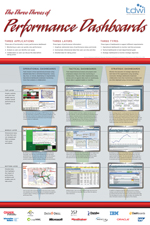Don’t Let Dashboards Drive You Crazy

There are days The Marketing Consigliere misses his Alfa Romeo Spider Veloce. Mainly when it’s sunny – not raining or snowing! It was a 1983 beauty – no airbags, no satellite radio, no GPS, no cup holder, no back window brakelight, no heated seats, no OnStar, no theft alarm – a car from a much simpler time (Remember when gas was $1.00 per gallon?).
Unlike the reputation of the brands of most Italian cars, his was both reliable and relatively economical – It was a great little four-banger. On nice days he could put the ragtop down, have a 360° view, and get from point “A” to point “B” with the simple analog dashboard that showed himspeed, engine rpm, oil pressure and water temperature.
Many businesspeople in leadership roles, especially those in SMBs, need to keep it simple when it comes to dashboarding. Yes, with business intelligence and data mining there are many things to report that would otherwise be undiscovered, but keeping it simple facilitates the speed with which today’s executives need to be decisive. TDWI (The Data Warehouse Institute™) is a great source for information on BI, data mining and dashboards.
Of course, determining the Key Performance Indicators (KPIs) for marketing and sales – such metrics as new customers, time to close, cost of customer acquisition, etc. – is important. Once the KPIs to measure have been defined, the dashboard that displays them to a user needs to have three major functions: 1. Monitoring for quick real-time viewing; 2. Analysis to identify root causes of variance; and 3. Collaboration so various users can discuss the data before taking action.
A good dashboard will also present three layers of information to users: 1. Graphical, abstracted views of situation and trending; 2. Summaries of dimensional data that can be cross tabbed on an ad-hoc basis; and 3. Actionable information with adequate detail.
Lastly, there are three types of essential dashboards for the enterprise: 1. Operational dashboards for mission-critical operational processes with frequently refreshed data; 2. Tactical dashboards to track deparmental performance updated on a weekly or monthly routine; and 3. Strategic dashboards to monitor the effectiveness of the enterprise as a whole.
 While companies are learning to use widgets and mashups to serve as a low level of tracking performance, they have a long way to go before matching the robustness of true dashboard offerings from vendors such as Cognos, Oracle, Microstrategy or SAP. These and other companies have chipped in to help TDWI create a poster that spells out what these dashboards do. While it was offered last year, there may be some left that you can have sent to you.
While companies are learning to use widgets and mashups to serve as a low level of tracking performance, they have a long way to go before matching the robustness of true dashboard offerings from vendors such as Cognos, Oracle, Microstrategy or SAP. These and other companies have chipped in to help TDWI create a poster that spells out what these dashboards do. While it was offered last year, there may be some left that you can have sent to you.
There are many more tools out there for the SMB that are affordable, such as Salesforce.com, with built-in dashboarding capabilities. The Marketing Consigliere encourages you to check them out as solutions that help you align marketing and sales. But remember, a dashboard can tell you what’s going on but you’re the one with your hands on the wheel and your foot on the pedal…
